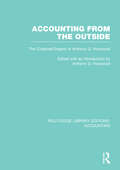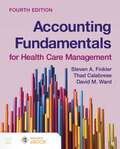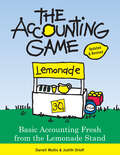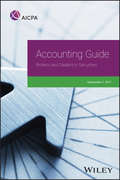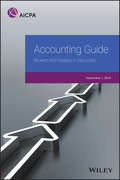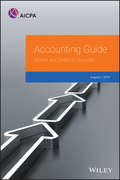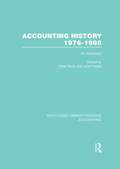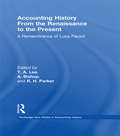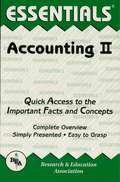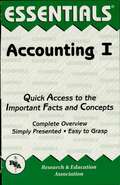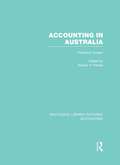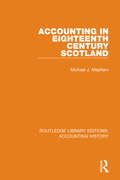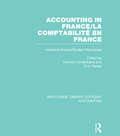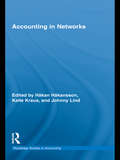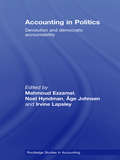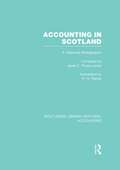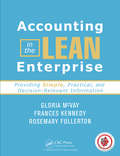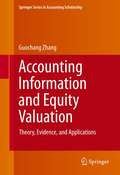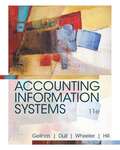- Table View
- List View
Accounting Framework, Financial Statements, and Some Accounting Concepts
by William J. Bruns Jr.Introduces the accounting framework, basic financial statements, and eleven accounting concepts.
Accounting Fraud at Tesco Stores (A)
by Jonas Heese Julia Kelley Suraj SrinivasanThis case describes the accounting fraud at Tesco Stores Limited (TSL), which was discovered by a senior accountant in TSL's finance department. The accountant was concerned about TSL's handling of commercial income, which, according to the accountant, overstated Tesco's profit by an estimated 246 million. Beyond the accounting issue, the case describes Tesco's organizational and cultural shortcoming causing this problem, how Tesco's new CEO Dave Lewis responded to the allegations, and how the court held the Tesco accountable for its fraudulent accounting. In September 2014, Amit Soni, a senior accountant in Tesco Stores Limited's (TSL) finance department filed a report with Tesco's legal team. Soni was concerned about TSL's handling of commercial income. According to the accountant's allegations, TSL employees had been inflating commercial income to meet the division's financial targets, causing Tesco's projected trading profit for the six months ended August 23, 2014 to be overstated by an estimated 246 million. Tesco's legal team had quickly referred the issue to CEO Dave Lewis, who had started in the role just a few weeks earlier, on September 1. Lewis had to decide how to respond to these allegations. Did the allegations have merit and what are the causes for the accounting violations? Should managers be removed if Tesco determined that the allegations had merit? What were the legal consequences for Tesco and how should Tesco's organizational structure and culture evolve?
Accounting Fraud at WorldCom
by David Kiron Robert S. KaplanThe principal players in WorldCom's accounting fraud included CFO Scott Sullivan, the General Accounting and Internal Audit departments, external auditor Arthur Andersen, and the board of directors. The case provides sufficient detail to allow for a full discussion of the pressures that lead executives and managers to "cook the books," the boundary between earnings smoothing or management and fraudulent reporting, the role for internal control systems and internal audit to prevent or rapidly detect accounting fraud, the expectations about governance processes performed by external auditors and the board of directors, and the pressure and consequences when middle managers follow orders that they know are wrong. Written from the public record, the case contains numerous quotes from an individual involved in the WorldCom fraud that were reported by the Investigative Committee and Wall Street Journal articles about several of the individuals caught up in the situation.
Accounting From the Outside: The Collected Papers of Anthony G. Hopwood (Routledge Library Editions: Accounting)
by Anthony G. HopwoodThe 43 papers in this collection, originally published from 1972 to 1987 delve into accounting, observing and exploring its functioning. They construct a basis for interrogating it in use and indeed they attempt to account for accounting. The author seeks to understand accounting, to appreciate what it is, what it does and how it does it, examining it from without rather than from within.
Accounting Fundamentals for Health Care Management
by Steven A. Finkler David M. Ward Thad CalabreseIdeal for an introductory course in financial accounting for health care, this essential text provides current and future healthcare managers with a solid foundation in the financial accounting and analysis skills needed within health care organizations. With Accounting Fundamentals for Health Care Management, students will learn how to assess financial information, ask the appropriate questions, and understand the jargon-laden answers. Key Features: Updated throughout to reflect the new Financial Accounting Standards Board (FASB) accounting standards, including implicit and explicit price concessions. Additional end-of-chapter questions and practice problems give student opportunities to apply chapter concepts Microsoft® Excel instruction has been enhanced with additional Excel screen shots and explanation
The Accounting Game: Basic Accounting Fresh from the Lemonade Stand
by Darrell Mullis Judith OrloffA clear, easy-to-understand explanation of key financial accounting basics.The world of accounting can be intimidating. Whether you're a manager, business owner, aspiring entrepreneur, or taking a college course in accounting, you'll find yourself need to know the basics...but baffled by complicated accounting books. What if learning accounting could be as simple and fun as running a child's lemonade stand? It can.The Accounting Game presents financial information in a format so simple and so unlike a common accounting textbook, you may forget you're learning skills that will help you get ahead! Using the world of a child's lemonade stand to teach the basics of managing your finances, this book makes a dry subject fun and understandable. As you run your stand, you'll begin to understand and apply financial terms and concepts like assets, liabilities, earnings, inventory and notes payable, plus:Interactive format gives you hands-on experienceColor-coded charts and worksheets help you remember key termsStep-by-step process takes you from novice to expert with easeFun story format speeds retention of essential conceptsDesigned to apply what you learn to the real worldThe revolutionary approach of The Accounting Game takes the difficult subjects of accounting and business finance and makes them something you can easily learn, understand, remember and use!Praise for The Accounting Game:"The game approach makes the subject matter most understandable. I highly recommend it to anyone frightened by either numbers or accountants."—John Hernandis, Director of Corporate Communications, American Greetings"Fantastic Learning Tool...Don't let this book title fool you. It is not an oversimplification of accounting and financial principles. It is, however, a serious and very effective examination of a very small but progressively complex business. There are not many books available on the market that make a complex and dry subject understandable and even fun. This book successfully does just that."—Amazon Reviewer
Accounting Guide: Brokers and Dealers in Securities
by AicpaThe 2017 edition gives up-to-date industry-specific guidance needed to be able to tailor operations with the most current standards and regulations. Included are new best practices and interpretive guidance to industry-specific considerations, this guide has you covered. This edition offers “best practice” discussion of industry-specific issues such as fair value accounting and related disclosures, as well as compliance with regulatory requirements. Further, new guidance on initial margin has been approved in accordance with applicable AICPA requirements.
Accounting Guide: Brokers and Dealers in Securities 2018 (AICPA)
by AicpaThe 2018 edition gives up-to-date industry-specific guidance needed to be able to tailor operations with the most current standards and regulations. Included are new best practices and interpretive guidance to industry-specific considerations, this guide has you covered. <P><P> This edition offers “best practice” discussion of industry-specific issues such as fair value accounting and related disclosures, as well as compliance with regulatory requirements. Further, new guidance on initial margin has been approved in accordance with applicable AICPA requirements.
Accounting Guide: Brokers and Dealers in Securities 2019 (AICPA)
by AicpaIt is critical to understand the complexities of the specialized accounting and regulatory requirements needed for the broker-dealer industry. This comprehensive guide has been designed to be beneficial for a wide range of professionals within the broker-dealer industry. Updates to this edition are to conform the content to current accounting standards and regulatory requirements. The updates include: SEC Release No. 34-86073, Amendment to Single Issuer Exemption for Broker-Dealers; ASU No. 2018-09, Codification Improvements; and, SEC Release Nos. 33-10532; 34-83875; IC-33203, Disclosure Update and Simplification. In addition, this edition features a new example disclosure note for revenue from contracts with customers, which has been added to the guide's illustrative financial statements and footnote disclosures.
Accounting History 1976-1986: An Anthology (Routledge Library Editions: Accounting)
by Peter Boys John FreearThe journal Accounting History was published in eight volumes intermittently between 1976 and 1986. It had a relatively small circulation and this re-issue of its anthology provides the opportunity for many of the articles which appeared in the journal over the years to once again reach a wider audience. The volume begins with items of a general nature, covering the importance of preserving accounting records and accounting history in general. Subsequent categories deal with the methodology of historical accounting research, government accounting, taxation, bankruptcy, professional accountancy and accounting theory, as well as auditing and management accounting.
Accounting History from the Renaissance to the Present: A Remembrance of Luca Pacioli (Routledge New Works in Accounting History)
by T. A. Lee R. H. Parker A. BishopFirst published in 1996. Routledge is an imprint of Taylor & Francis, an informa company.
Accounting I Essentials
by Duane MilanoREA's Essentials provide quick and easy access to critical information in a variety of different fields, ranging from the most basic to the most advanced. As its name implies, these concise, comprehensive study guides summarize the essentials of the field covered. Essentials are helpful when preparing for exams, doing homework and will remain a lasting reference source for students, teachers, and professionals. Accounting I includes accounting principles, the accounting cycle, adjusting entries, closing entries, worksheet procedures, accounting for a merchandising operation, internal control and specialized journals, cash, receivables, inventory, property, plants and equipment, and long-term assets.
Accounting I Essentials
by Duane MilanoREA’s Essentials provide quick and easy access to critical information in a variety of different fields, ranging from the most basic to the most advanced. As its name implies, these concise, comprehensive study guides summarize the essentials of the field covered. Essentials are helpful when preparing for exams, doing homework and will remain a lasting reference source for students, teachers, and professionals. Accounting I includes accounting principles, the accounting cycle, adjusting entries, closing entries, worksheet procedures, accounting for a merchandising operation, internal control and specialized journals, cash, receivables, inventory, property, plants and equipment, and long-term assets.
Accounting in Australia: Historical Essays (Routledge Library Editions: Accounting)
by Robert H. ParkerThe history of accounting in Australia is of interest because it provides an opportunity to examine how accounting techniques, institutions and concepts have been imported and adapted to an environment similar to, but not exactly the same as that of the exporters. The book emphasizes private sector accounting over public sector accounting which is a reflection of the available literature but not of the real world of Australian accounting and is divided into 7 sections: Early Accounting Records The Financial Year Corporate Financial Reporting Audit Professional Accountancy Accounting Literature Biographies and Bibliographies
Accounting in Eighteenth Century Scotland (Routledge Library Editions: Accounting History #3)
by Michael J. MephamThis book, first published in 1988, is a study of the development of accounting in eighteenth century Scotland. The investigation is organised around a survey of early Scottish accounting texts, an analysis of their exposition of the Italian method of book-keeping and their treatment of certain selected topics. The aim is to evaluate the contribution that these Scottish accountants made to the development of a profession.
Accounting in France: Historical Essays/Etudes Historiques (Routledge Library Editions: Accounting)
by Yannick Lemarchand R. H. ParkerThis volume illustrates the research not only of French accountants (Colasse, Durand, Jouanique, Lemarchand, Nikitin, Richard, Tessier) but also the work of Belgian authors writing in French (Stevelinck, Haulotte) and of French non-accountants (de Swarte, Durdilly, Sauvy). The work of British and North American academics, writing in English on French accounting history is also illustrated from the 1930s (Howard, Edwards), through to the 1960s (Parker) and the more recent research of Standish, Fortin and Bhimani. The contributions to this volume have been arranged both chronologically and thematically as follows: the earliest business accounting records; the first French accounting authors; Colbert, Savbary and the Ordonnance de Commerce; the eighteenth and nineteenth centuries; cost accounting; the national accounting plan; national income accounting; government accounting and accounting theory. An abstract of each contribution is given in both English and French.
Accounting in Networks (Routledge Studies in Accounting)
by Håkan Håkansson Kalle Kraus Johnny LindAccounting in Networks is the first book that in a comprehensive way covers the emerging issue of accounting and control in horizontal relations across legally independent organizations. During the last 20 years, organisations have shown an increased interest in collaborations that cross company boundaries. New organisational forms, such as alliances, partnerships, joint ventures, outsourcing and networks have received increased attention. This development has pushed management accounting researchers into examining the lateral effects of accounting. This book examines these lateral effects on accounting, and creates a comprehensive summary of what has been achieved so far and what interesting developments will occur in the coming ten years. The book covers a variety of inter-organizational settings – dyads, networks, joint ventures, public sector – and the roles of accounting therein. It also deals with specific inter-organizational accounting techniques – customer accounting, target costing and open book accounting – which companies use to manage in a world of inter-organizational relationships and networks. The book also covers different theoretical perspectives – transactional cost economics, the industrial-network approach, actor-network theory, institutional theory – on accounting in networks. Each chapter focus on a specific angle of accounting in networks, assess theoretical and empirical evidence, summarize the current position/debate and discuss promising avenues for future research.
Accounting in Politics: Devolution and Democratic Accountability (Routledge Studies In Accounting Ser. #Vol. 5)
by Mahmoud Ezzamel Noel Hyndman Åge Johnsen Irvine LapsleyThis book looks at the effectiveness of the 1999 restructuring of the UK through the establishment of the Scottish Parliament and the Assemblies for Northern Ireland and Wales, considering the process of devolution and its consequences on the key mechanisms of accounting and democratic accountability. Many of the chapters in this book examine wheth
Accounting in Scotland: A Historical Bibliography (Routledge Library Editions: Accounting)
by Janet E. Pryce-Jones R. H. ParkerThe first Scottish book on accounting was published in 1683. That book heralded a century during which Scotland established its reputation as a land of accountants: a steady stream of books subsequently appeared from Scottish presses. This bibliography contains over 330 location entries, including 32 non-UK libraries. Periodical articles as well books are included.
Accounting in the Lean Enterprise: Providing Simple, Practical, and Decision-Relevant Information
by Gloria McVay Frances Kennedy Rosemary FullertonDespite the obvious need for transparency, a company‘s Lean results can continue to hide behind the mask of traditional accounting and dilute the benefits of a Lean implementation. When your organization opts to go Lean, you must empower your accountants with Lean tools that serve the Lean mission.Winner of a Shingo Research and Professional Public
Accounting Information and Equity Valuation: Theory, Evidence, and Applications (Springer Series in Accounting Scholarship #6)
by Guochang ZhangThe purpose of this book is to offer a more systematic and structured treatment of the research on accounting‐based valuation, with a primary focus on recent theoretical developments and the resulting empirical analyses that recognize the role of accounting information in making managerial decisions. Since its inception, valuation research in accounting has evolved primarily along an "empirically driven" path. In the absence of models constructed specifically to explain this topic, researchers have relied on economic intuition and theories from other disciplines (mainly finance and economics) as a basis for designing empirical analyses and interpreting findings. Although this literature has shed important light on the usefulness of accounting information in capital markets, it is obvious that the lack of a rigorous theoretical framework has hindered the establishment of a systematic and well‐structured literature and made it difficult to probe valuation issues in depth. More recently, however, progress has been made on the theoretical front. The two most prominent frameworks are (i) the "linear information dynamic approach" and (ii) the "real options‐based approach" which recognizes managerial uses of accounting information in the pursuit of value generation. This volume devotes its initial chapters to an evaluation of the models using the linear dynamic approach, and then provides a synthesis of the theoretical studies that adopt the real options approach and the empirical works which draw on them. The book also makes an attempt to revisit and critique existing empirical research (value-relevance and earnings-response studies) within the real options-based framework. It is hoped that the book can heighten interest in integrating theoretical and empirical research in this field, and play a role in helping this literature develop into a more structured and cohesive body of work. Value is of ultimate concern to economic decision-makers, and valuation theory should serve as a platform for studying other accounting topics. The book ends with a call for increased links of other areas of accounting research to valuation theory.
Accounting Information Systems
by Ulric J. Gelinas Richard B. Dull Patrick Wheeler Mary Callahan HillAs an accounting professional, you are expected to help organizations identify enterprise risks and provide quality assurance for the company's information systems. <P><P>You can rely on ACCOUNTING INFORMATION SYSTEMS, 11E's clear presentation to help you understand the two issues most critical to accounting information systems in use today: enterprise systems and controls for maintaining those systems. <P><P> ACCOUNTING INFORMATION SYSTEMS, 11E explores today's most intriguing accounting information systems (AIS) topics and details how these issues relate to business processes, information technology, strategic management, security, and internal controls. The authors focus on today's most important advancements, using a conversational tone rather than complex technical language to ensure you develop the solid foundation in AIS that you need to be successful.

